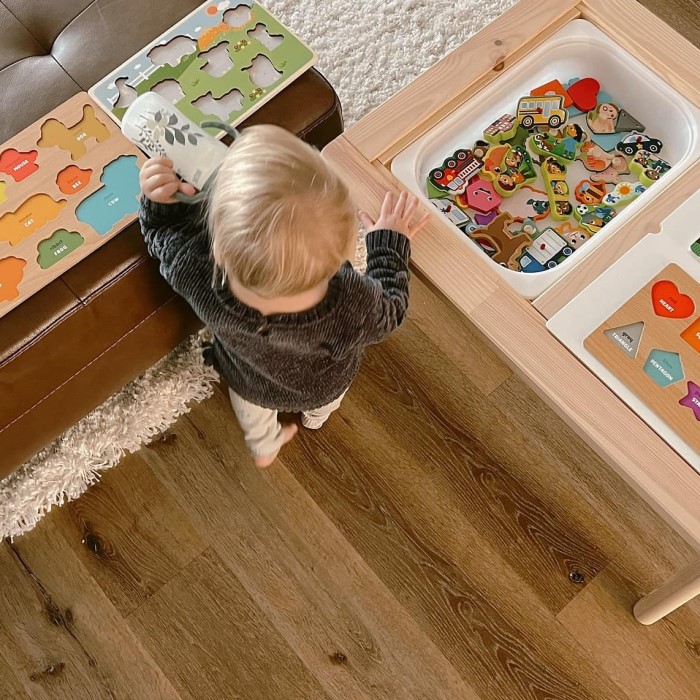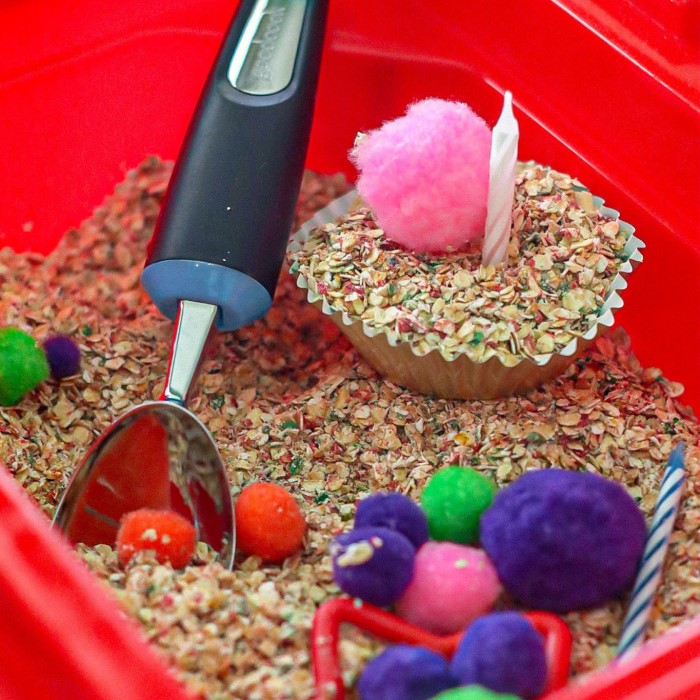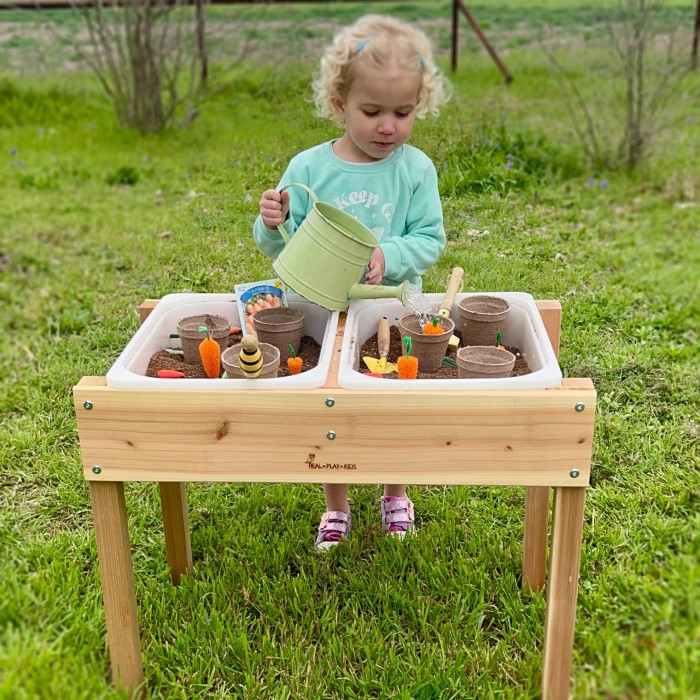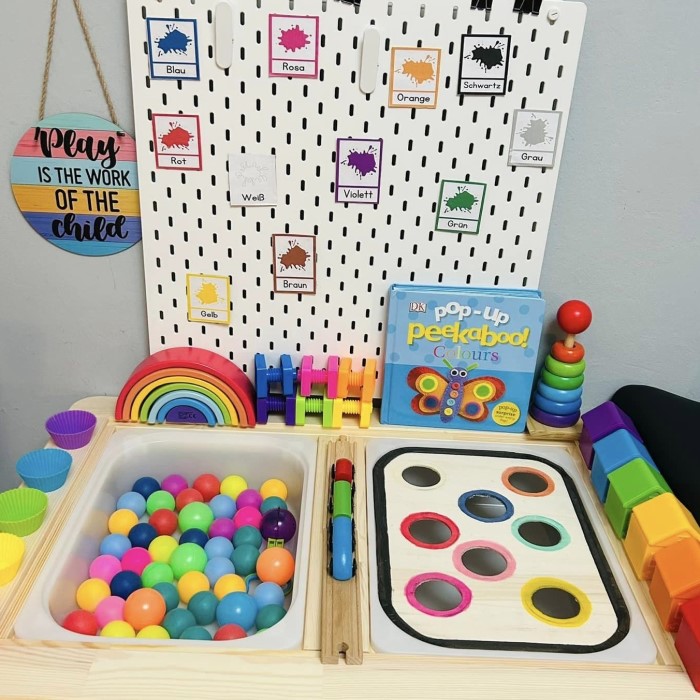Introduction to Sensory Table Ideas
Sensory play is an essential part of early childhood development. It allows children to explore and engage with their environment using their senses. One of the best ways to encourage sensory exploration is by creating a sensory table. In this article, we’ll dive into sensory table ideas that focus on creativity while providing fun and learning for kids. These ideas will inspire you to create engaging, educational experiences that foster development.
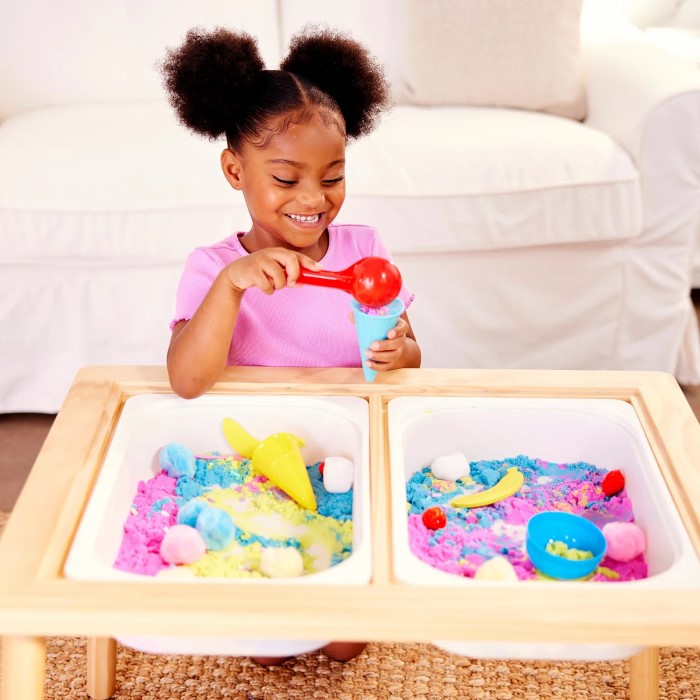
Benefits of Sensory Play
Sensory play is vital for child development. It engages the senses and supports learning in fun ways.
Enhancing Cognitive Development
Sensory tables stimulate children’s brains. Exploring textures, colors, and sounds builds problem-solving skills. Handling sensory items boosts memory, focus, and critical thinking. It also encourages curiosity and creativity.
Supporting Fine Motor Skills
Using sensory tables strengthens hand and finger muscles. Activities like pouring, scooping, and pinching refine coordination. Repeated actions improve dexterity and hand-eye coordination, readying kids for writing and drawing.
Promoting Social Interaction
Sensory play encourages teamwork and sharing. Group activities create opportunities for communication. Children learn to express ideas, resolve conflicts, and build friendships. It’s a fun way to foster social skills in kids of all ages.
Choosing the Right Sensory Table
Selecting the right sensory table ensures successful and engaging sensory play experiences for kids. Factors like materials, size, and design play a crucial role in making the table suitable for children of different ages and activities. Below, we explore essential considerations to help you choose wisely.
Materials Suitable for Sensory Tables
The materials used for sensory tables impact safety, durability, and functionality. Here are some great options:
- Plastic: Lightweight, easy to clean, and ideal for wet or messy sensory activities.
- Wood: Sturdy and eco-friendly, but make sure it is treated for water resistance.
- Metal: Durable and suitable for older kids, though it may not work for wet tasks.
- Acrylic: Transparent surfaces enable kids to see through, adding extra visual stimulation.
Choose materials that are safe, smooth, and free of sharp edges. Avoid toxic paints or finishes, and ensure the table is built for frequent use.
Best Sizes and Designs for Every Age Group
Sensory tables come in various sizes and designs, catering to different needs:
- For Toddlers: Look for small tables with lower heights for easy access. Ensure rounded edges and simple designs.
- For Preschoolers: Medium-sized tables with adjustable legs work well. Include sections for different activities.
- For Older Kids: Larger tables with complex designs can enhance their creativity. Consider themed or multipurpose tables.
Plan for sufficient depth in sensory bins to hold materials securely. If using water or sand, choose tables with drainage holes or removable tubs. Collapsible or portable tables can save space and enhance usability in smaller settings.
By prioritizing the right materials and designs, you ensure a sensory table that engages kids safely and effectively.
Seasonal Sensory Table Ideas
Sensory tables can reflect the charm of each season. Incorporating seasonal themes keeps activities fresh and exciting for kids.
Spring-Themed Tables
Celebrate spring with flower petals, green grass, and colorful plastic eggs. Fill bins with potting soil for planting seeds or small flowers. Add toy insects and magnifying glasses for bug observation activities. Incorporate pastel colors and natural textures to engage kids’ senses.
Summer Sand and Water Play
Summer sensory tables can include sand, water, and beach-inspired activities. Offer scoops, funnels, and buckets for sandcastle building. Add seashells, smooth rocks, and small plastic sea creatures. Include ice cubes or frozen toys to explore melting and cooling processes.
Autumn Leaves and Nature Exploration
Capture autumn vibes with dry leaves, acorns, and pinecones. Add pumpkins or gourds for variety. Use magnifying glasses to study textures and patterns in nature items. Incorporate warm colors like orange and yellow, and let kids explore sensory bins filled with materials like dried corn kernels.
Winter Snow and Ice Activities
Create winter scenes with fake snow, cotton balls, and ice cubes. Add mittens and plastic snowflake shapes for tactile exploration. Kids can build mini snowmen using shaving cream or soft dough. Incorporate blue, white, and silver shades for a frozen, winter-inspired feel.
Seasonal sensory tables offer endless ways to connect children to the wonders of every season.
DIY Sensory Table Ideas
Creating your own sensory table can save money and add a personal touch. It’s a great way to customize activities for your child’s needs. Below are some simple and affordable DIY sensory table ideas.
Budget-Friendly Solutions
You don’t need to spend a lot to create sensory tables. Here are some cost-effective ideas:
- Plastic Storage Bins: Use shallow bins or tubs as the main sensory container. These are easy to find and inexpensive.
- Cardboard Boxes: Reinforce sturdy cardboard boxes with tape to hold lightweight sensory materials like rice or pasta.
- Folding Tables: Repurpose small, adjustable-height folding tables. Place bins on top for an instant sensory table.
- PVC Pipes and Connectors: Build a simple frame to hold sensory bins. This makes a durable and lightweight solution.
- Dollar Store Finds: Purchase inexpensive tools like scoops, spoons, or funnels. Use them to enhance your sensory activities.
These solutions let you mix and match items based on your budget and creativity.
Recycled and Upcycled Materials
Give old items a new purpose by incorporating recycled or upcycled materials into sensory tables:
- Old Drawers or Desk Trays: Turn unused drawers or desk trays into small sensory bins. Paint or line them for a fresh look.
- Bottle Caps and Lids: Collect plastic bottle caps or jar lids for sorting and color-matching activities.
- Repurposed Furniture: Use an old coffee table or nightstand as the base for a sensory setup. Add storage below if needed.
- Food Containers: Clean yogurt cups, cookie tins, or ice-cream tubs for pouring and scooping activities.
- Fabric Scraps and Ribbons: Use leftover fabric pieces for texture-based activities, encouraging tactile exploration.
Reusing materials not only saves money but also helps teach kids the value of sustainability.
These DIY sensory table ideas are simple, creative, and perfect for fun and engaging play.
Themed Sensory Table Concepts
Themed sensory tables offer endless possibilities for enriching play. They combine fun with creative learning.
Science Experiments for Kids
Create a sensory table full of science-based activities. Include baking soda and vinegar for volcano experiments. Add magnets and metal objects to explore magnetism. Use water beads or slime for tactile science fun. Include magnifying glasses for kids to observe small objects closely. Mix safe ingredients to create fizzy reactions. This theme encourages curiosity and a love for discovery.
Imaginative Play with Story Themes
Bring storybooks to life with sensory tables. For fairy tales, add glitter, gems, and small figurines. Use sand, shells, and toy boats for pirate adventures. Include plastic dinosaurs and toy trees for prehistoric play. Add miniature castles and knights for a medieval theme. Let children create their own stories while exploring textures and objects. This inspires creative thinking and storytelling skills.
Exploring Cultural Diversity
Introduce kids to different cultures with themed sensory tables. Include items like rice, spices, and small artifacts. Use materials representing cultural festivals, such as lanterns or traditional clothing pieces. Add musical instruments or symbols from various countries. Incorporate world maps and flags for a global learning experience. This theme promotes cultural awareness and appreciation. It’s an engaging way to teach kids about diversity.
Tips for Setting Up a Sensory Table
Setting up a sensory table effectively ensures kids have a safe and enjoyable experience. Follow these tips for an engaging and secure play environment.
Safety Measures to Keep in Mind
Safety is essential when creating a sensory table setup. Follow these key tips:
- Supervise Play: Always watch children during sensory activities to prevent accidents or choking hazards.
- Age-Appropriate Materials: Choose items that are suitable for the child’s age and development level.
- Avoid Small Objects: For younger kids, avoid small items like beads that could cause choking.
- Non-Toxic Materials: Use non-toxic and child-safe sensory materials like edible items or washable substances.
- Smooth Edges: Ensure the table and tools have no sharp edges that could cause injuries.
- Regular Cleaning: Clean sensory materials and tools frequently to maintain hygiene and prevent germs.
By keeping these safety measures in mind, playtime remains safe and enjoyable for everyone.
Tools and Accessories for Maximum Fun
The right tools and accessories make sensory play more interactive and exciting. Consider adding these:
- Scoops and Spoons: Kids love using scoops and spoons for pouring and transferring sensory materials.
- Funnels and Strainers: These add variety and stimulate problem-solving skills during play.
- Mini Buckets or Bowls: Perfect for collecting and organizing sensory items.
- Colorful Objects: Use bright toys, buttons, or pom-poms to introduce color recognition activities.
- Tactile Tools: Add brushes, sponges, or textured mats for hands-on exploration.
- Measuring Cups: Inspire early math concepts by using cups for measuring and volume exploration.
- Themed Accessories: Incorporate items like animal figures, alphabet blocks, or seasonal objects to match themes.
By including a variety of tools, you encourage endless creative possibilities for kids to learn and play.
Extending Learning Through Sensory Play
Sensory play can be more than just fun. It provides excellent opportunities for learning and creativity.
Incorporating Educational Components
Link sensory activities with educational elements to teach valuable skills while kids play.
- Early Math: Use measuring cups or scales to introduce concepts like weight, volume, and comparison.
- Science Exploration: Include materials like magnets, water beads, or seeds for scientific discovery and experimentation.
- Language Growth: Label sensory items or ask kids to describe textures and objects to improve vocabulary.
- Problem-Solving Skills: Create simple challenges, like building structures or organizing items by color or size.
- Counting and Sorting: Use blocks, beads, or buttons for counting exercises and color or shape sorting tasks.
Adding these components makes sensory tables a fun teaching tool while enhancing kids’ knowledge.
Encouraging Creative Expression
Sensory play encourages kids to express themselves freely and explore their imaginations.
- Artistic Play: Add washable paints, clay, or chalk to the table for creative art projects.
- Role-Playing Scenarios: Offer toys, figurines, or themed objects for pretend play and storytelling.
- Design and Build: Include building tools and materials like sand or blocks to inspire construction activities.
- Customizable Themes: Let kids choose items to create their own imaginary worlds.
- Color Mixing Fun: Provide safe dyes or paints to explore color blending and artistic creativity.
When kids can explore freely, their confidence and creative thinking skills grow substantially.
Maintaining and Cleaning Sensory Tables
Proper maintenance and cleaning keep sensory tables safe and ready for use. Children interact closely with these tables, so hygiene and durability are vital. Below are essential tips.
How to Keep Tables Hygienic and Safe
Maintaining hygiene prevents the spread of germs and ensures safe play. Follow these steps regularly:
- Daily Cleaning: Wipe down tables after each use with child-safe disinfectant.
- Wash Materials: Clean sensory items like toys, scoops, or trays with soap and warm water.
- Dry Thoroughly: Ensure all items, especially wet materials, are dried completely to prevent mold.
- Replace Contaminated Items: Discard materials that show signs of wear, damage, or contamination.
- Use Removable Bins: Choose tables with removable trays or bins for easy cleaning access.
- Avoid Edible Items: Do not reuse food-based sensory materials for multiple sessions.
- Protect Delicate Items: Store fragile items separately to avoid damage during cleaning.
A hygienic table guarantees safety and enjoyment for kids during sensory play.
Long-Term Care and Storage Options
Proper storage and care extend the lifespan of sensory tables and accessories. Adopt these strategies:
- Store Indoors: Keep sensory tables in a dry, indoor space to prevent exposure to weather damage.
- Organize Accessories: Use labeled bins to store sensory tools and materials separately.
- Cover Tables: Protect tables from dust by using lightweight covers when not in use.
- Inspect Regularly: Check for cracks, loose parts, or signs of wear, repairing them promptly.
- Rotate Materials: Avoid wear by rotating sensory items and preventing overuse.
- Disassemble When Needed: Detachable tables make storage compact and reduce the chances of damage.
- Use Airtight Containers: Store materials like sand or beads in sealed containers to keep them clean.
Proper care ensures sensory tables stay functional and enjoyable for a long time.
Conclusion: Embrace Sensory Play
In conclusion, sensory table ideas offer engaging and educational experiences for kids. By incorporating these creative setups into your routine, you can foster learning through play. Sensory tables are versatile and can be tailored to suit different themes and seasons.
Encouraging sensory exploration opens the door to developmental growth. Therefore, take the time to set up a sensory table that excites your children. Through touch, sight, sound, and even taste, kids will thrive, learn, and enjoy their time exploring the world around them.
